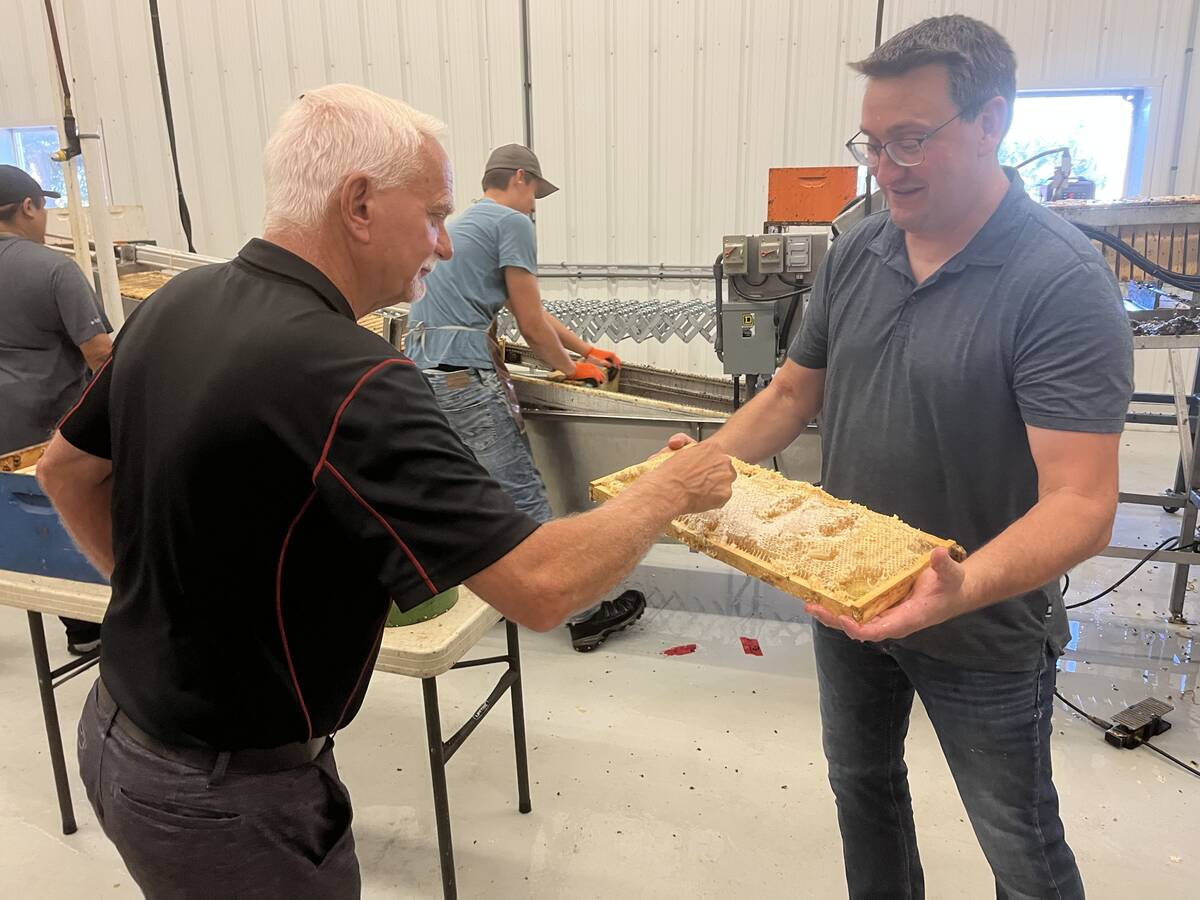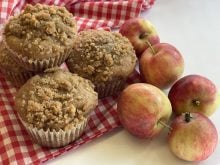What a beautiful bright day we have as this article is being written. The morning sunrises and evening sunsets that we enjoy on the farm are perks we take for granted. During the holidays, I tried to capture this beauty on film to retain for future memories, and to send to our son in Australia.
Yesterday we admired the mirage, where the hills in the distance looked like gigantic mountains with the scene changing from minute to minute.
In Saskatoon where I’m taking classes this year, I notice it is often impossible to witness these magnificent landscape views.
Read Also

Alberta honey business ‘thrives’ despite bumpy beginnings
Thrive Honey showcases its honey production in market where Alberta produces 40 per cent of all honey produced in the country
With the holiday season behind us we are anxious to eat smaller quantities of healthier dishes. With the empty nest now, we eat less. I make a large quantity of food and freeze it in small containers for one or two. We grow lentil varieties of different colors and sizes, so I am always looking for new pulse recipes or adaptations. We had a delicious dish of baked beans during the holidays. Our friend added small green lentils and kabuli chickpeas to his traditional recipe.
Baked beans
- 21/4 cups beans 550 mL
- 5 cups water 1.25 L
- 2 teaspoons dry mustard 10 mL
- 1/4 teaspoon pepper 1 mL
- 2 teaspoons salt 10 mL
- 2 tablespoons barbecue sauce 30 mL
- 4 tablespoons ketchup 60 mL
- 1/2 cup small green lentils 125 mL
- 1/2 cup kabuli chickpeas 125 mL
- 1 onion, sliced
- 1/4 cup brown sugar 50 mL
- 5 tablespoons molasses 65 mL
- 1/2 pound salted pork or bacon (sliced) 250 g
- Pick and wash the beans. Soak them overnight. Drain liquid and replace with an equal amount of hot water. Then prepare the beans to bake in the oven.
- Mix the mustard, salt, pepper, barbecue sauce and ketchup. Add to the liquid from the beans. Put half the liquid and half the beans into the pot.
- Add onion, lentils and chickpeas and layer with the remaining beans, brown sugar, molasses and pork.
- Cook in covered container in the oven or in slow cooker about six hours at 400 F (200 C).
- Remove the cover for the last hour. Add tomato juice as extra liquid if the beans become dry.
Serves six to eight.
The two cookbooks I use most when cooking pulses are The Amazing Legume and Discovering the Pulse Potential, both available from Saskatchewan Pulse Growers or Food Focus. One of the recipes I collected is a quick bean dish to take to potluck suppers.
Three-bean bake
- 1 can baked beans (14 oz.) 398 mL
- 1 can chickpeas (14 oz.) 398 mL
- 1 can kidney beans (14 oz.) 398 mL
- 2 cups chopped onion 500 mL
- 1 cup chopped sweet green pepper 250 mL
- 2 garlic cloves, minced
- 2 tablespoons canola oil 25 mL
- 1 tablespoon all-purpose flour 15 mL
- 2 tablespoons molasses 25 mL
- 1 tablespoon sodium-reduced soy sauce 15 mL
- 1/2 teaspoon ground ginger 2 mL
- pinch of chili powder
- Preheat oven to 325 F (160 C).
- Combine chick peas, baked beans and kidney beans in a two-quart (2 L) casserole.
- In a large skillet, saute onion, pepper and garlic in oil until onion is translucent. Stir in flour, then add molasses, soy sauce, ginger and chili powder. Bring to a boil.
- Pour over beans and stir lightly.
- Cover and bake one hour.
- Uncover and bake 30 minutes, or until thick.
For more information, call 306-652-2691 or e-mail foodfocus@quadrant.net. The website address is www.skpulse.sk.ca.
Flaxseed can be added to recipes to improve the nutritional content. It has been consumed throughout history for its nutritional and health benefits. When I was teaching home economics several years ago, the class experimented with flaxseed in a variety of recipes. The students liked the flax puffed wheat cake better than the regular recipe.
Flax is rich in alpha-linolenic acid (an essential omega-3 fatty acid), dietary fibre (soluble and insoluble) and plant lignans. Omega-3s may help protect against heart disease and stroke. Soluble fibre reduces blood cholesterol levels and insoluble fibre improves laxation. Researchers believe lignans assist in the prevention of breast and colon cancer more than any other plant.
Flax can be used as a substitute for fat and for eggs in recipes. To substitute for fat in a recipe, use three tablespoons (45 mL) ground flaxseed for each tablespoon (15 mL) of margarine, butter or cooking oil. Baking with flax will cause baked goods to brown more quickly. Substitute a ground flaxseed-water mixture for eggs in recipes such as pancakes, muffins and cookies. Use one tablespoon (15 mL) ground flax plus three tablespoons (45 mL) water (left sitting for several minutes) for each egg. This will result in a chewier version of the recipe, with less volume.
Use flaxseed whole, or grind it in a coffee grinder, food processor or blender, to the consistency of finely ground coffee.
Grinding ensures that all seeds are broken up, thus providing the most nutritional benefit. For optimum freshness, it is best to grind when you need it. Ground flaxseed can be stored in the fridge for up to 90 days. Store whole flaxseed at room temperature for up to a year.
To incorporate flax into your cooking, the Flax Family Favorites recipes and healthful tips booklet is available from the Flax Council of Canada at 204-942-1841, fax 204-942-1841 or check the website at www.flaxcouncil.ca.
Recently, Colleen Ruddy won a bread machine in a food contest on the Flax Council of Canada’s website. The following is her recipe:
Flax and fruit muffins
- 11/2 cups rolled oats 375 mL
- 1 cup whole wheat flour 250 mL
- 1/2 cup ground flaxseed 125 mL
- 1 teaspoon baking powder 5 mL
- 1 teaspoon baking soda 5 mL
- 1 teaspoon ground cinnamon 5 mL
- 1/2 teaspoon nutmeg 2 mL
- 1/2 teaspoon ginger 2 mL
- 2 large bananas, mashed
- 1/2 cup vanilla soy milk (or regular) 125 mL
- 1/4 cup egg whites 50 mL
- 1/4 cup molasses 50 mL
- 1/4 cup honey 50 mL
- 4 tablespoons unsweetened apple sauce 50 mL
- 1 teaspoon vanilla extract 5 mL
- 1 cup frozen berries (blackberries, blueberries or raspberries) 250 mL
- Preheat oven to 400 F (200 C). Because flax has a tendency to brown quickly you may have to lower your oven temperature.
- Put paper muffin cup liners in a 12-muffin tin.
- In a large bowl, mix oats, flour, flaxseed, baking powder, baking soda, cinnamon, nutmeg and ginger. In a medium bowl, mix bananas, soy milk, egg whites, molasses, honey, applesauce and vanilla. Pour liquid into flour mixture and stir to combine. Stir in berries.
- Spoon into the muffin cups, filling them full. Bake approximately 22 minutes. Remove from cups.
Yield: 12 muffins.
Tastes of Saskatchewan
Many readers who have attended Canadian Western Agribition will know about the unique food demonstration sponsored by Saskatchewan Agriculture in the Prairie Cuisine area. Chefs from Culinary Team Saskatchewan prepare provincially made and grown products daily. During the week, visitors sample food that may include pork, bison, canola, wild rice, fallow deer, wild boar, lamb, goat, elk, trout, ostrich, chicken, turkey, eggs, flax, honey, dairy and beef.
There is a wonderful booklet of these recipes available free from your local extension office with Saskatchewan Agriculture. Agriculture Means the World to Saskatchewan is a collection of almost 100 recipes that were created for Tastes of Saskatchewan since its inception. Here is a recipe we will use often on salad greens.
Saskatoon berry vinaigrette
- 1 cup canola oil 250 mL
- 1/4 cup saskatoon berry syrup 50 mL
- 1 tablespoon vinegar 15 mL
- 1 tablespoon finely chopped green onion 15 mL
- 1/4 teaspoon dijon mustard 1mL
- dash of salt and pepper
Combine all ingredients. Chill and serve on your favorite lettuces.
By chef Steve Driver, 1999.
















